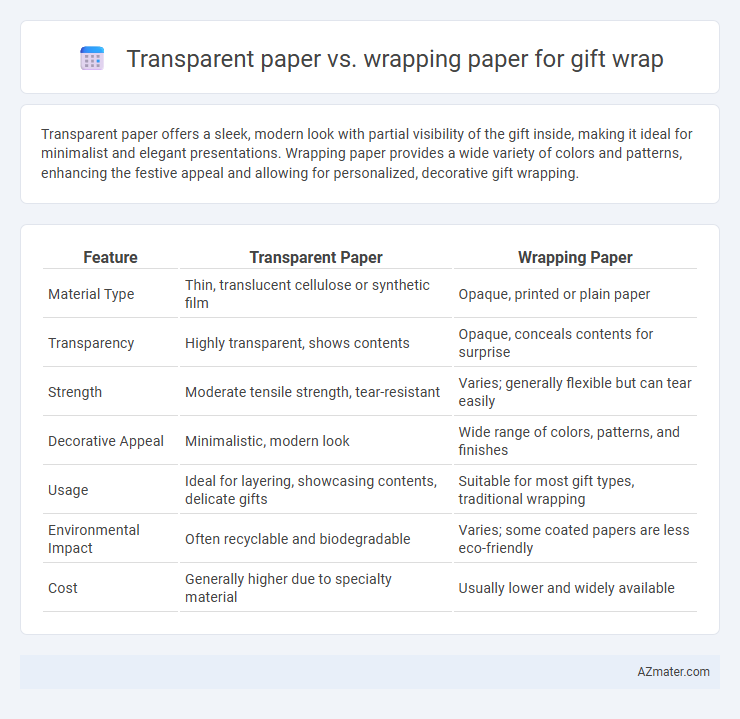Transparent paper offers a sleek, modern look with partial visibility of the gift inside, making it ideal for minimalist and elegant presentations. Wrapping paper provides a wide variety of colors and patterns, enhancing the festive appeal and allowing for personalized, decorative gift wrapping.
Table of Comparison
| Feature | Transparent Paper | Wrapping Paper |
|---|---|---|
| Material Type | Thin, translucent cellulose or synthetic film | Opaque, printed or plain paper |
| Transparency | Highly transparent, shows contents | Opaque, conceals contents for surprise |
| Strength | Moderate tensile strength, tear-resistant | Varies; generally flexible but can tear easily |
| Decorative Appeal | Minimalistic, modern look | Wide range of colors, patterns, and finishes |
| Usage | Ideal for layering, showcasing contents, delicate gifts | Suitable for most gift types, traditional wrapping |
| Environmental Impact | Often recyclable and biodegradable | Varies; some coated papers are less eco-friendly |
| Cost | Generally higher due to specialty material | Usually lower and widely available |
Understanding Transparent Paper: Features and Uses
Transparent paper, also known as vellum or tracing paper, is a semi-transparent material characterized by its smooth texture and durability, making it ideal for creative gift wrapping that showcases the gift inside. Unlike traditional wrapping paper, transparent paper allows for layering effects and can be combined with other decorative elements such as ribbons or dried flowers to enhance visual appeal. Its moisture-resistant and tear-resistant properties make it a practical choice for protecting delicate items while maintaining an elegant presentation.
What Is Wrapping Paper? Types and Varieties
Wrapping paper is a decorative material used to cover gifts, enhancing presentation and creating anticipation for the recipient. It comes in various types, including traditional printed paper, metallic foil, fabric wraps, and transparent paper, each offering unique textures and visual effects. Transparent paper, often made of cellophane or vellum, adds a subtle, glossy layer that showcases the gift inside, while traditional wrapping paper provides vibrant colors and patterns to suit different occasions.
Aesthetic Appeal: Transparent Paper vs Wrapping Paper
Transparent paper enhances the aesthetic appeal of gift wrapping by showcasing the gift inside, adding a modern, minimalist charm with a subtle sheen that highlights decorative elements like ribbons or tags. Wrapping paper offers a vibrant and customizable appearance through a vast range of colors, patterns, and textures, creating a visually striking presentation tailored to the occasion. The choice between transparent and traditional wrapping paper affects the overall visual impact, with transparency focusing on simplicity and elegance, while printed wrapping paper emphasizes bold design and thematic expression.
Durability and Protection for Gifts
Transparent paper offers moderate durability with its thin yet flexible texture, making it ideal for showcasing the gift while providing basic protection against dust and scratches. Wrapping paper tends to be thicker and more robust, delivering superior protection from impacts and environmental damage during handling and transport. For gifts requiring enhanced durability and safeguarding, wrapping paper ensures better defense, whereas transparent paper excels in aesthetic presentation with light protection.
Customization and Creative Possibilities
Transparent paper offers unmatched customization by allowing printed designs, personal photos, and intricate patterns to shine through, enhancing the visual appeal of gifts with a modern, sleek look. Wrapping paper provides a vast array of textures, colors, and finishes that cater to traditional and themed designs, enabling creative layering and embellishments like ribbons and tags. Combining transparent paper with wrapping paper expands creative possibilities, allowing for unique presentations that highlight both the gift and its decorative elements.
Environmental Impact: Recyclability and Sustainability
Transparent paper, often made from cellulose fibers, is biodegradable and more easily recyclable compared to traditional wrapping paper coated with plastic or metallic finishes, which hinder recycling processes. Wrapping paper with non-recyclable embellishments or plastic laminates contributes to landfill waste and increases environmental pollution. Choosing transparent paper promotes sustainability by reducing microplastic contamination and supporting circular waste management systems.
Cost Comparison: Transparent vs Wrapping Paper
Transparent paper generally costs less than traditional wrapping paper due to its minimalist design and lower material usage, making it a budget-friendly option for gift wrapping. Wrapping paper often includes decorative prints and embossing, which increase production expenses and retail prices. Bulk purchases of transparent paper can further reduce costs, whereas specialty or festive wrapping paper tends to be more expensive per sheet.
Ease of Use: Folding, Cutting, and Wrapping
Transparent paper offers superior ease of use for gift wrapping due to its flexibility and smooth texture, allowing effortless folding and precise cutting without tearing. Wrapping paper often features thicker, printed surfaces that can be stiffer and more prone to creasing or ripping during intricate folds. For quick, neat wrapping, transparent paper reduces complications and enhances the overall presentation with minimal effort.
Which Paper Stands Out for Special Occasions?
Transparent paper offers a sleek, modern look by revealing the gift inside, making it ideal for showcasing intricate or luxurious presents during special occasions. Wrapping paper, with its wide variety of colors, patterns, and textures, provides a more traditional and festive appearance that enhances the excitement before unwrapping. For elegant, minimalist celebrations, transparent paper stands out, while wrapping paper remains the top choice for vibrant, themed events.
Choosing the Best Option for Your Gift Wrap Needs
Transparent paper offers a sleek, modern look that showcases the gift inside, making it ideal for delicate items or personalized presents. Wrapping paper provides a wide variety of patterns and textures, perfect for adding festive flair and hiding the contents completely. Selecting the best option depends on whether you prioritize visibility and elegance (transparent paper) or decorative variety and surprise (wrapping paper).

Infographic: Transparent paper vs Wrapping paper for Gift wrap
 azmater.com
azmater.com